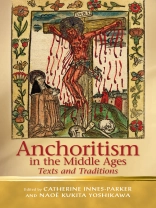This volume explores medieval anchoritism (the life of a solitary religious recluse) from a variety of perspectives. The individual essays conceive anchoritism in broadly interpretive categories: challenging perceived notions of the very concept of anchoritic ‘rule’ and guidance; studying the interaction between language and linguistic forms; addressing the connection between anchoritism and other forms of solitude (particularly in European tales of sanctity); and exploring the influence of anchoritic literature on lay devotion. As a whole, the volume illuminates the richness and fluidity of anchoritic texts and contexts and shows how anchoritism pervaded the spirituality of the Middle Ages, for lay and religious alike. It moves through both space and time, ranging from the third century to the sixteenth, from England to the Continent and back.
สารบัญ
Introduction Catherine Innes-Parker and Naoe Kukita Yoshikawa Part One: Traditions of Anchoritic Guidance 1. Can there be such a thing as an ‘anchoritic rule’? Bella Millet 1. The Role of the Anchoritic Guidance Writer: Goscelin of St. Bertin Mari Hughes-Edwards 2. Logical Discourse Markers in Julian of Norwich Fumiko Yoshikawa Part Two: Enclosure and Sanctity in Hagiographical Tradition 3. Heresy and Heterodoxy: The Feminized Trinities of Marguerite Porete and Julian of Norwich Jane Chance 4. Hagiography and Idealism: St Dympna of Geel, an Uncanny Saint Juliana Dresvina 5. Bridal Mysticism and the Politics of the Anchorhold: Dorothy of Montau Sieglinde Hartmann Part Three: Anchoritic Texts and Traditions in the Lay World 6. Secularization in Ancrene Wisse, Part 1: The ‘Pater noster’, ‘Credo’, and ‘Ave’ Chiyoko Inosaki 7. Reading and Devotional Practice: The Wooing Group Prayers of British Library, MS Cotton Nero A.xiv Catherine Innes-Parker 8. Carmelite Spirituality and the Laity in the Late Medieval England Naoe Kukita Yoshikawa 9. Printing and Reading Walter Hylton in Early Tudor England Satoko Tokunaga







![ปกของ Brian Schrag & Julisa Rowe: Community Arts for God's Purposes [Chinese] 貼近神心意的社群藝術 ปกของ Brian Schrag & Julisa Rowe: Community Arts for God's Purposes [Chinese] 貼近神心意的社群藝術](https://static.worldofdigitals.com/thumb_webp/740/9781645083740.webp)




